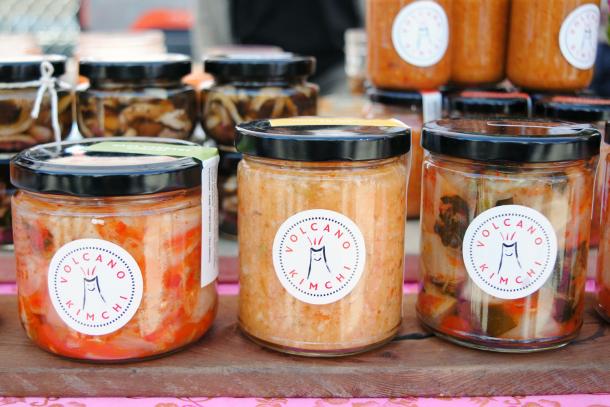Volcano Kimchi Does Banchan Bay Area Style
Brie Mazurek, CUESA Staff
June 23, 2017

“Some people say, ‘I don’t like kimchi,’ because they have this image of kimchi as a salty, fishy, and made with MSG,” says Aruna Lee, maker of Volcano Kimchi. “But when they taste my organic kimchi, they’re like ‘wow!’”
Each jar of Aruna’s vegan kimchi is packed with the fresh and crisp flavors of her childhood growing up in a Buddhist monastery in South Korea, translated through her experiences moving to the Bay Area. “It was an amazing kind of kimchi,” she remembers. “I just want to share it with people.”
Today, she brings Volcano Kimchi to the Ferry Plaza Farmers Market, where visitors are eager to enjoy the delicious benefits of farm-fresh probiotic ferments.

Mountains of Cabbage
The journey from Aruna’s taste memory to her modern-day San Francisco kitchen was a long and winding one. At age six, Aruna was adopted by a Buddhist monk, and she spent all of her youth at a temple deep in the mountains.
“I would go out into the vegetable garden and pick vegetables,” she recalls. “It was all organic, and I’d just harvest them right there, rinse them in the creek, and eat them.”
Because of the lack of electricity and refrigeration, fruit and vegetables grown at the monastery had to be preserved. Living in community with 250 nuns at Buddhist seminary school, she would participate in the seasonal kimchi making, preserving mountains of cabbage into nutritious ferments to provide sustenance through the long winter season.
“You have to have kimchi for almost every meal, so you make a lot!” she says. I remember we made it in these big public bathtubs, like a big jacuzzi. We’d brine cabbage in that tub, then bring it to the creek and rinse it to make the kimchi.”
“On a winter night, you get hungry so you go out and you pick some of that winter kimchi, dongchimi. And when you slice it on a cold night, you can see the ice on top of the kimchi. You eat it with sweet potato baked on charcoal, and I remember just how delicious it was—so, so delicious.”
Later, on a pilgrimage trip to India, she met an American named Peter Schurmann and fell in love. She moved to San Francisco with him in 2001 and became a reporter for a nonprofit media company. “I never really thought that I would leave the temple, because I really loved that lifestyle. It’s very simple, living in the mountains, meditating. But things happen—all the curiosity in life.”

Reimagining Temple Kimchi
The memory of winter kimchi stayed with her. When she became pregnant with her son, Leon, she found herself craving the deeply nourishing food of the Buddhist temple, and began making kimchi on her own. In 2014, she rented space in a shared commercial kitchen and launched her own kimchi business using her credit card.
“I don’t have exact recipes for how they made the kimchi, but I remember the taste, so I just experimented,” she laughs. Temple kimchi was vegan (no fish sauce or shrimp paste), which she remained true to, while adding her own flair. For example, she uses garlic and green onions, which were not permitted in the monastery because they were believed to arouse the senses.
To make the kimchi, Aruna brines the raw vegetables with French grey sea salt, then blends them with a chili paste, and leaves them to ferment naturally for two or three days at room temperature before bottling it to bring to market.
Drawing from California’s bounty, Aruna uses locally sourced and organic (when possible) ingredients, playing and adapting to suit her farmers market finds. In Aruna’s seasonally rotating jars, you may find Napa cabbage from Eatwell Farm, mushrooms from Far West Fungi, and Aedan Fermented’s miso. Pears are used in place of refined sugars.
While many people assume that the eponymous “volcano” refers to kimchi’s spicy heat, Aruna’s kimchi tends toward the mild side, to showcase the range of flavors in the jar. Her son, Leon, came up with the name and drew the logo of a smiling volcano when he was eight years old, inspired by the effervescent bubbles that percolate to the top of a newly opened jar of kimchi, a natural byproduct of the beneficial bacteria that make raw fermentation possible.

Setting the Banchan Table
Bubbling in Aruna’s passion for kimchi is a deeper mission: inspiring people to enjoy healthful, homemade meals together. “I want to have a banchan,” she says, referring to the Korean way of eating that involves sharing many small fermented side dishes, served alongside a protein or rice.
Because kimchi can last for weeks to months in the fridge, it makes for a convenient go-to for spicing up any number of preparations: a dab or dip of ssamjang miso paste on meat or vegetables, a filling of pickled “Magic Mushroom” in your omelette, or a spoonful of jicama kimchi salsa over your tamale or quesadilla.
“All those little dishes you just have to pull out of your refrigerator to have a meal,” she says. “You don’t have to go out or order in pizza. You can bring a healthy dinner table to people. That’s what I want to do.”
Having a stand at the Ferry Plaza Farmers Market provides plenty of inspiration to experiment and dream up new styles of kimchi and combinations of banchan, while receiving instant feedback from the community. “Every week I can make something new and offer it to customers,” she says. “I’m not just selling products. I’m offering an experience to visitors to the market.”
Try Volcano Kimchi at the Ferry Plaza Farmers Market on Saturdays.
Topics: Food makers
